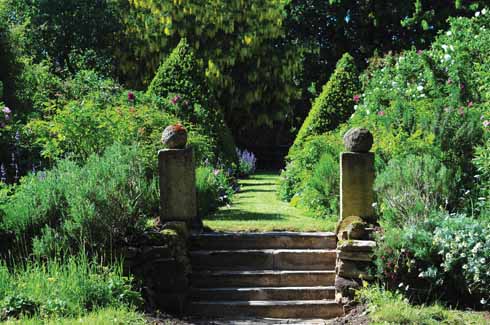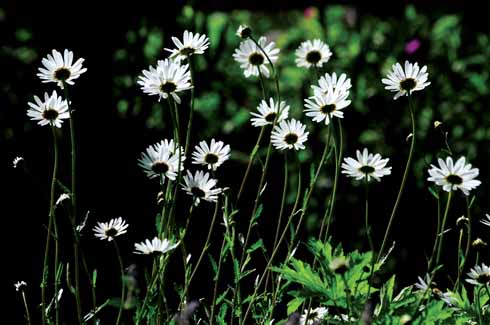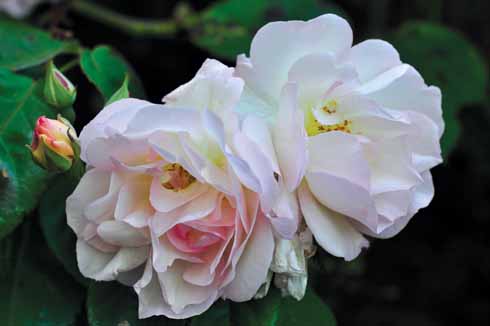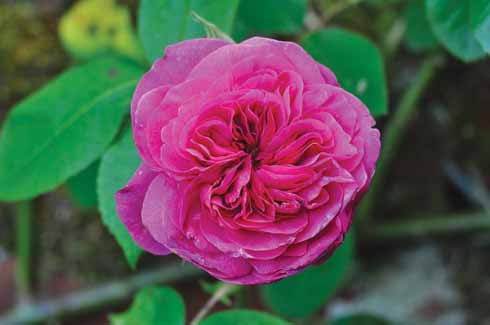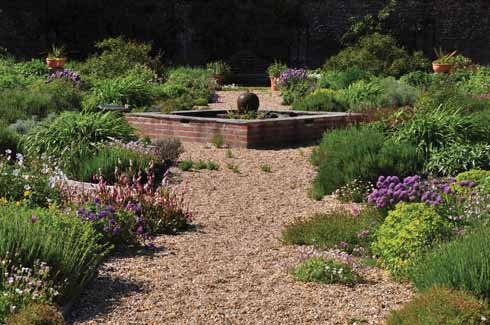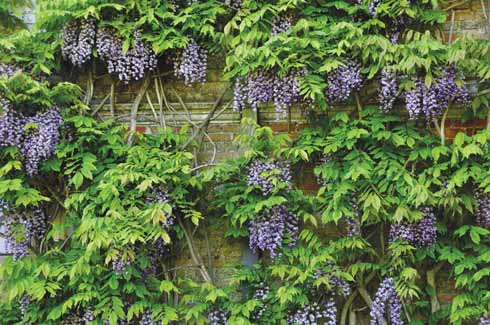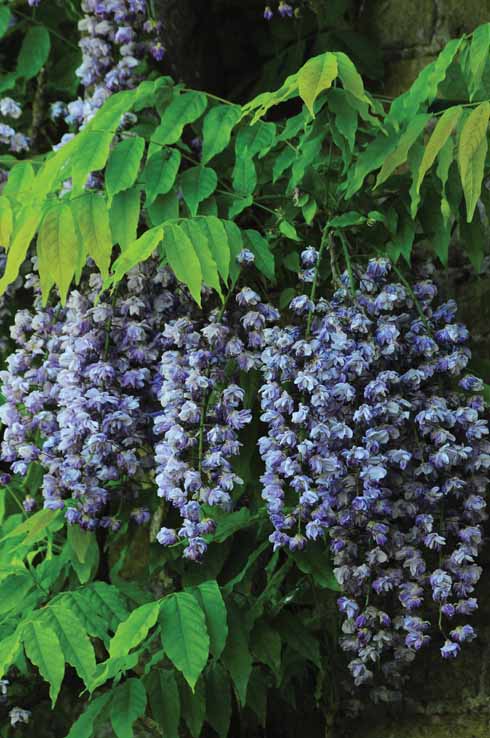A Dorset garden: Anderson Manor
Susy and Colin Varndell visit a three-acre garden on the River Winterborne
Published in May ’16

A view along the Ladies’ Walk beside the River Winterborne. Weathered and lichen-covered brick and stone are a soft form of hard landscaping that only comes with clean air and time.
Anderson Manor, a Grade I listed Jacobean manor house, nestles at the end of a tree-lined avenue. These delightful gardens have a wealth of features to explore: a topiary garden, a bowling green, old hedges, herbaceous borders, a gravelled ladies’ walk, a walled garden within which is a gravel garden parterre and an orchard, a lime walk, and the beginnings of a memory woodland.
The present owners, who have been guardians of the manor and the garden for the past forty years, are trying gradually to restore the gardens to their former glory. The 1910 layout is their blueprint. The division of labour is distributed according to preferences: Jeremy, who likes straight lines, is responsible for the geometric topiary, the yew hedges and the box parterre; Clive, the gardener, is responsible for all the planting schemes (amongst other things); and Rosemary maintains the grass and keeps the weeds at bay. Although maintaining such a garden is a great deal of hard work, it is clear that the guardians enjoy every minute of the project. The garden is on the edge of chalk but with a gravel alkaline heavy soil above, which does create some problems.

A view of the topiary garden: it is a wonderful mix of formal elegance, with its box-edged beds and topiary, enclosing the imaginative box sculptures within
The gravel parterre garden, which was designed by Clive, was only a few years ago a bed of stinging nettles. Now it is a magnificent sight. The job began with clearing the site and rotovating it, followed by planting using Mypex and wood chippings. Mypex is a landscaping fabric which cuts down the ensuing maintenance considerably. Its advantage is that it offers long-term, chemical-free, weed prevention. It is porous and therefore allows both air and water down into the soil and it helps to retain soil moisture and maintain the soil temperature.
The results speak for themselves: the parterre is full of colour and interest. The ground cover plants spread joyously over the gravel paths, creating a feel of abundance and profusion. All these plants were carefully chosen to ensure that they attracted bees and insects and were no more than eighteen inches high at maturity. This has been achieved admirably and the insects have plenty to feed on.
Colourful foliage is a feature of this part of the garden, with plants such as Heuchera villosa ‘Palace Purple’ and the aromatic Salvia officinalis ‘Purpurea’ being prime examples. Herbs are grown in profusion here, with drought-tolerant thyme and the insect meccas, oregano and rosemary, providing foliage and scent as one wanders around this heavenly place.
The Mediterranean aroma in the summer evenings is palpable along with the background humming of numerous insects. There is even space for wild flowers such as bladder campion (Silene vulgaris). The prolific Phuopsis stylosa is encouraged as it is such a magnet for insects. Chives grow profusely and with great vigour. Rosemary, who delights in wavy lines, with no regimented plants and everything growing over edges, must be delighted with the results of her labour.

Phuopsis Stylosa: a close-up of a Phuopsis flower with its small, narrowly funnel-shaped pink flowers
It is difficult to drag oneself away to investigate the rest of the grounds, which is ridiculous, as the remainder of the garden turns out to be just as magical. The topiary garden is a wonderful mix of formal elegance, with its box-edged beds and topiary enclosing the imaginative box sculptures within. One can only admire the designer of such creations and the work that must go into maintaining such fascinating shapes. The topiary garden is overlooked by a carefully trained pleached lime avenue. This masterpiece of interlacing branches is carefully pruned every January with the help of the visiting family.
The Ladies’ Walk, which runs along the River Winterborne, is a riot of colourful roses and peonies. The well-weathered brick walls are smothered with old-fashioned varieties of rambling roses which have been here a long time. These varieties include Rosa Blanc de Coubert and Rosa Zéphirine Drouhin, which has a wonderfully scented deep pink bloom. Rosa Gertrude Jekyll can also be seen. It is a superb healthy rose, which has beautiful rich pink rosettes with a quintessential English rose fragrance. Rosa Alberic Barbier, a vigorous, healthy climber which has yellow buds which open to double, fragrant, creamy-white flowers and are held in small clusters, flowers abundantly on this wall. Clive takes cuttings regularly in order to keep the stock replenished
The bowling green borders, which were replanted three years ago, are backed by old yew hedges which need to be kept in careful check. At the far end is a feature bench, which leads the eye around the planted area. Moving on to the colour co-ordinated herbaceous border, one can see a magnificent laburnum tree at the far end which frames the subtle blue and white planting.This border, at the back of the house, runs parallel with the gravel parterre and is planted with a mixture of persicaria, geraniums, lupins and huge thistle-like Cynara cardunculus (cardoon). The planting is based on colour and availability.
The orchard is full of old west country varieties of apples such as Malus domestica, Cornish Gilliflower and Ashmeads Kernel. These unusual varieties of apple are used to make juice, which is then frozen. Indeed, a freezer had to be bought especially to house the wonderful drink. Russet apples, which are also grown, are good for eating and keep well into January.
The memory woodland is planted with trees to commemorate various anniversaries. A Liquidambar tree was recently planted to add to the collection; these trees are primarily grown for their maple-like leaves, which take on a brilliant and long-lasting autumn colour. Unfortunately, the pocket handkerchief tree, or Davidia involucrata, has been reluctant to flower ever since it was planted.
These wonderful gardens, which have been transformed and restored over forty years, are a credit to the present owners. They in turn praise Clive, their gardener, who has used his wide experience to keep the garden manageable and beautiful and has developed strategies for coping with such a big garden without allowing it to rule one’s life. ◗
Anderson Manor is open under the NGS on Thursday 26 May and Thursday 9 June, 2.00-4.30, entrance £4.50. Details at www.andersonmanor.co.uk or www.ngs.org.uk
